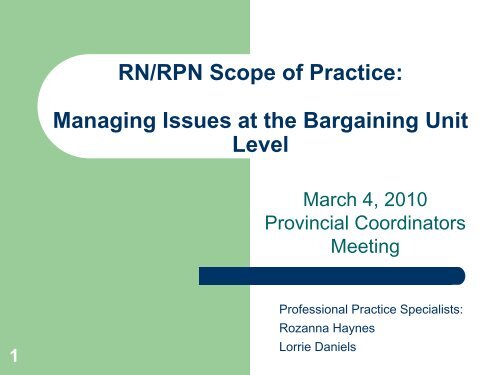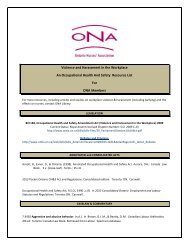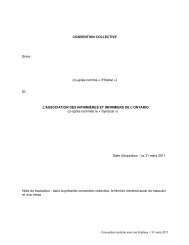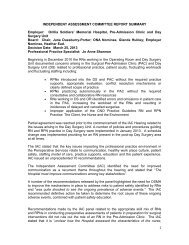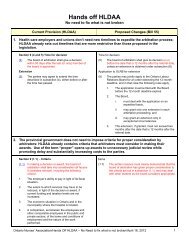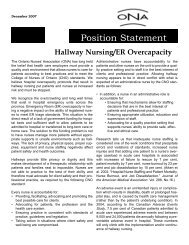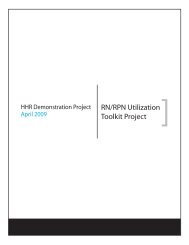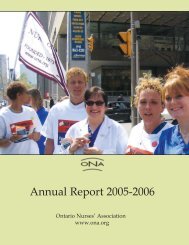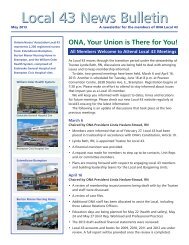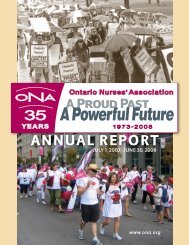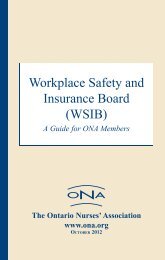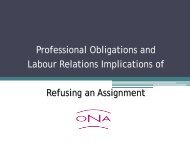Presentation - RN/RPN Scope of Practice - Ontario Nurses ...
Presentation - RN/RPN Scope of Practice - Ontario Nurses ...
Presentation - RN/RPN Scope of Practice - Ontario Nurses ...
Create successful ePaper yourself
Turn your PDF publications into a flip-book with our unique Google optimized e-Paper software.
<strong>RN</strong>/<strong>RPN</strong> <strong>Scope</strong> <strong>of</strong> <strong>Practice</strong>:<br />
Managing Issues at the Bargaining Unit<br />
Level<br />
March 4, 2010<br />
Provincial Coordinators<br />
Meeting<br />
1<br />
Pr<strong>of</strong>essional <strong>Practice</strong> Specialists:<br />
Rozanna Haynes<br />
Lorrie Daniels
OBJECTIVES<br />
2<br />
• Provide clarity <strong>of</strong> the roles <strong>of</strong> the BUP, LRO<br />
and PP Specialist<br />
• Leaders to gain a better understanding <strong>of</strong> the<br />
differing roles <strong>of</strong> the <strong>RN</strong>, and the <strong>RPN</strong><br />
• Identify resources available and how to<br />
access them<br />
• Establish problem-solving techniques<br />
• Red Flags-Identify change factors/trends to<br />
be watchful for
College <strong>of</strong> <strong>Nurses</strong> <strong>of</strong> <strong>Ontario</strong> -<br />
The Three Factor Framework<br />
Interactive Module<br />
• http://www.cno.org/prac/learn/modules/utiliza<br />
tion/chapter2/index.htm<br />
3
CHARGE NURSE<br />
• Charge Nurse, Team Leader,<br />
Resource Nurse<br />
• “Charge nurses are a staff resource<br />
providing leadership and expertise to the<br />
nursing team to help them provide quality<br />
care to clients.”<br />
-CNO, Communiqué September 2002<br />
4
Role <strong>of</strong> the Charge Nurse<br />
• “As the leader, the charge nurse holds a pivotal role on<br />
the unit”<br />
• “As self-regulated pr<strong>of</strong>essionals each nurse is<br />
accountable for his or her own actions and decisions.”<br />
• “While charge nurses are not accountable for the<br />
actions <strong>of</strong> others, they are accountable for their<br />
actions in relation to others.”<br />
• CNO, Communiqué September, 2002<br />
5
CHARGE NURSE<br />
6<br />
• Current work environments<br />
– Fast paced<br />
– Lines <strong>of</strong> communication break down<br />
– Responsibilities become blurred<br />
– Charge nurses may not know who needs<br />
help<br />
– New and novice nurses may not know how<br />
to ask for help; where to find it; or that they<br />
need help
USE OF AGENCY NURSES<br />
7<br />
• When working with agency nurses the charge<br />
nurse and the agency nurse should have initial<br />
discussions to identify areas <strong>of</strong> strength and<br />
potential gaps in knowledge, pertaining to the<br />
specific environment<br />
• In this way, the charge nurse can ensure<br />
appropriate resources and systems are in<br />
place to support agency nurses
CHARGE NURSE<br />
The main question becomes - who is<br />
responsible for client outcomes and<br />
who should have followed up when a<br />
client’s condition changed?<br />
8
Implications for the Nurse in Charge<br />
9<br />
• Charge nurses have been found to have<br />
committed pr<strong>of</strong>essional misconduct for failing to<br />
provide adequate supervision to a nurse under<br />
their direction<br />
• When in charge, it is better to have taken pro<br />
active steps to stop potential problems, rather<br />
than reacting to problems after they arise<br />
• The following actions can assist the charge<br />
nurse in fulfilling her responsibilities to lead the<br />
team and head <strong>of</strong>f potential problems early
CHARGE NURSE<br />
• Know your role<br />
– Be accountable for actions in relation to others<br />
– Act as a resource by sharing knowledge and expertise<br />
10<br />
• Taking Charge<br />
– Know who is most likely to need your help<br />
– Get mini-reports throughout the shift<br />
– Ask the right question<br />
– Be clear about who is responsible for what<br />
– Take action to stop unsafe situation<br />
– Be a leader<br />
– Assign right patient to right category <strong>of</strong> nurse<br />
– Allot enough time for consultation and collaboration
Scenario<br />
Nurse-Client Assignment<br />
• As an <strong>RPN</strong>, I have always been assigned<br />
four clients in the ward room and one or two<br />
other clients in a semi-private room. Recently<br />
the charge nurse has been doing the<br />
assignment differently and I have clients in<br />
different rooms.<br />
11
The Charge Nurse based the change in<br />
assignment on …….<br />
a) Continuity <strong>of</strong> care<br />
b) Care fragmentation<br />
c) Client complexity, environmental<br />
supports and the availability <strong>of</strong><br />
consultation<br />
12<br />
d) A system <strong>of</strong> odd and even room numbers
ANSWER<br />
13<br />
• The Nurse-client assignment changes were<br />
based on client complexity, environmental<br />
supports and the availability <strong>of</strong> consultation<br />
• Nurse-client assignments based on bed or<br />
room number are not client focused, they do<br />
not consider the clients needs or complexity.<br />
• <strong>RN</strong>s can autonomously care for any<br />
complexity <strong>of</strong> client,<br />
• <strong>RPN</strong>s autonomously meet the needs <strong>of</strong> less<br />
complex clients
ANSWER<br />
14<br />
• If an <strong>RPN</strong> is assigned to more complex clients the care<br />
must be done in consultation with <strong>RN</strong>s<br />
• <strong>RN</strong> consultative time can vary from shift to shift OR<br />
week day to weekend<br />
• This factor influences how nurse patient assignments<br />
are made ie. an <strong>RPN</strong> is assigned moderately complex<br />
clients during the day shift when an <strong>RN</strong> resource nurse<br />
is available, however when the night <strong>RPN</strong> comes to<br />
work and no <strong>RN</strong> resource nurse is available, they<br />
should not be assigned the same complexity <strong>of</strong> client<br />
but rather to less complex clients that the <strong>RPN</strong> can<br />
care for autonomously
ANSWER<br />
15<br />
The third factor the charge nurse must consider is the<br />
availability <strong>of</strong> environmental supports<br />
• Are there clear policies that guide nursing practice<br />
• Are there care pathways and medical directives that<br />
help nurses with decision making<br />
• Are there clear and easy to use assessment tools<br />
• Is there support in the form <strong>of</strong> time and expertise for<br />
consultation<br />
Answering these questions will help determine<br />
the stability <strong>of</strong> the environment
A workplace environment that supports<br />
<strong>RN</strong>/<strong>RPN</strong> collaborative practice will have<br />
a) an <strong>RN</strong> available for consultation, or to<br />
whom the <strong>RPN</strong> can transfer care if necessary<br />
b) support tools (ie. assessment tools, policy<br />
and procedures), clear role descriptions and<br />
responsibilities <strong>of</strong> all care providers<br />
c) all <strong>of</strong> the above<br />
16<br />
d) none <strong>of</strong> the above
ANSWER<br />
• Workplace environments that support<br />
collaborative practice will have a high<br />
proportion <strong>of</strong> <strong>RN</strong>s and <strong>RPN</strong>s familiar with the<br />
type <strong>of</strong> clients<br />
• There will be an <strong>RN</strong> available for consultation<br />
or to whom the <strong>RPN</strong> can transfer care if<br />
necessary<br />
• Support tools and clear role descriptions and<br />
responsibilities <strong>of</strong> care providers<br />
17
NURSE FACTORS<br />
Nurse factors that impact the<br />
effective decision making include:<br />
Both <strong>RN</strong>s and <strong>RPN</strong>s care<br />
<strong>RN</strong>s<br />
for Individuals, families, also care for<br />
groups<br />
communities and<br />
populations<br />
<strong>RN</strong>s and <strong>RPN</strong>s develop plans <strong>of</strong> care to achieve client goals<br />
18<br />
<strong>RPN</strong>s<br />
develop plans <strong>of</strong> care when<br />
over all client needs are less<br />
complex, outcomes are<br />
predictable and risk <strong>of</strong> negative<br />
outcomes is low<br />
<strong>RN</strong>s<br />
develop broad plans <strong>of</strong> care<br />
over longer periods <strong>of</strong> time,<br />
incorporating a variety <strong>of</strong><br />
options and resources
NURSE FACTORS<br />
Nurse factors that impact practice<br />
decisions include that<br />
<strong>RPN</strong>s<br />
<strong>RN</strong>s<br />
-meet immediate (current) -meet both immediate<br />
client care needs<br />
and long term client needs<br />
-consult with <strong>RN</strong>s -act as a resource to<br />
and other health care <strong>RPN</strong>s to meet client<br />
team members needs<br />
19
NURSE FACTORS<br />
Leadership<br />
20<br />
<strong>RPN</strong><br />
demonstrates leadership<br />
through representation on<br />
Committees, precepting with<br />
students and direction to UCP<br />
<strong>RN</strong><br />
assumes the role <strong>of</strong> leader<br />
within the interpr<strong>of</strong>essional<br />
team,<br />
leads the team effort to<br />
develop plans <strong>of</strong> care<br />
to achieve identified client goals<br />
when overall care requirements<br />
are more complex
Can a charge nurse assign an <strong>RPN</strong> to conduct an<br />
admission assessment on a client arriving at a<br />
hospital inpatient unit?<br />
a) yes, depending on the <strong>RPN</strong><br />
b) no, never under any circumstances<br />
c) maybe - depending on the <strong>RN</strong>/<strong>RPN</strong><br />
staffing level on the unit<br />
d) yes - but only if the clients health condition<br />
has been assessed first<br />
21
ANSWER<br />
• The client stability should be established, before an <strong>RPN</strong> is assigned<br />
to a client. This can be accomplished by written or verbal report or an<br />
assessment by an <strong>RN</strong><br />
• The CNO states that a <strong>RN</strong> must conduct the triage assessment in the<br />
ER however there is NO legislation or standard that states the <strong>RPN</strong><br />
can not conduct the admission assessment on a unit.<br />
• <strong>RPN</strong>s can be expected to complete an admission client assessment<br />
when the health condition is stable, the health status is predictable and<br />
the health outcomes can be expected to follow an anticipated path.<br />
• The <strong>RPN</strong> may determine that the client care needs and/or the<br />
assessment needs are more in depth than the <strong>RPN</strong>s competencies<br />
• This may require consultation with the <strong>RN</strong> or transfer <strong>of</strong> care to the <strong>RN</strong><br />
22
Trends/Red Flags<br />
23<br />
• Changing Models <strong>of</strong> Care<br />
• Fragmentation <strong>of</strong> care - the disjointed and<br />
disconnected delivery <strong>of</strong> nursing care services by<br />
multiple care providers, inconsistent with continuity<br />
<strong>of</strong> care.<br />
• Skill Mix - “the distribution <strong>of</strong> nursing<br />
personnel per skill category (i.e. <strong>RN</strong>, <strong>RPN</strong>)<br />
and per skill level.” (<strong>RN</strong>AO, 2010)<br />
• Physician Assistants
CONFIRMED <strong>RN</strong> ROLES<br />
24<br />
• The Charge Nurse<br />
• The Triage Nurse<br />
• The Resource Nurse<br />
• The primary circulating nurse in the operating room<br />
• The discharge planner<br />
• The primary nurse caring for the sedated patient –<br />
OPANA - “2 <strong>RN</strong>s both competent in perianesthesia<br />
nursing, must be present at any time when a patient is<br />
recovering immediately following anesthesia, until<br />
transfer to phase II recovery”
Issues for Nurse Staffing<br />
– Be alert to……<br />
25<br />
• The proportion <strong>of</strong> <strong>RN</strong>s to other or less<br />
qualified staff<br />
• The number <strong>of</strong> nursing hours per patient per<br />
day - hppd<br />
• The ratio <strong>of</strong> <strong>RN</strong>’s to patient /clients<br />
• The number <strong>of</strong> full-time equivalents (FTE)<br />
• The percentage <strong>of</strong> FT, PT and casual staff<br />
• The mix <strong>of</strong> demographic characteristics ie.<br />
education and experience
Other Considerations<br />
• It is important to ensure that collaboration<br />
and consultation occurs during transfer <strong>of</strong><br />
accountability (TOA)<br />
26<br />
• Be aware <strong>of</strong> <strong>RPN</strong> documentation indicating<br />
‘<strong>RN</strong> notified’, the client condition needs to be<br />
clearly communicated to the <strong>RN</strong> and<br />
documented in the chart
Ongoing considerations<br />
Interpr<strong>of</strong>essional care<br />
• <strong>RN</strong>AO - watch for team nursing<br />
• <strong>Practice</strong> environments enable or disable<br />
nurses in their ability to provide safe patient<br />
care<br />
• Client factors – acuity equals the number <strong>of</strong><br />
nursing interventions required in a 24 hour<br />
period, issues with the patient during a 24 hour<br />
period<br />
27
Pr<strong>of</strong>essional <strong>Practice</strong> Role<br />
28<br />
• Research-Use research to develop arguments related to<br />
current pr<strong>of</strong>essional practice concerns, and write position<br />
papers.<br />
• Retention- Maintain and enhance the current staffing by<br />
resolving pr<strong>of</strong>essional issues and encouraging employers to<br />
create a respectful work environment<br />
• Network and Lobby -Pr<strong>of</strong>essional practice specialists maintain<br />
relationships with organizations including the CNO, <strong>RN</strong>AO and<br />
specialty organizations like the National Case Managers<br />
Association, etc<br />
• We provide information and interpretation on standards and<br />
pr<strong>of</strong>essional practice issues to members and LRO.<br />
• Provide education on CNO, PRCs, etc, for the LRO and<br />
members as requested.
What can we do for you?<br />
• Pr<strong>of</strong>essional <strong>Practice</strong> Specialists will work<br />
with you to develop strategies tailored to your<br />
specific circumstances<br />
• We communicate and support membership<br />
and LRO on Pr<strong>of</strong>essional <strong>Practice</strong><br />
issues/concerns<br />
29
What can we do for you?<br />
• Provide members with possible solutions for resolving issues at the<br />
employer association committee (EAC).<br />
• Provide members and the LRO with information and interpretation re<br />
standards and practice issues. Act as a resource person on all<br />
pr<strong>of</strong>essional practice matters.<br />
• Consult with LRO on pr<strong>of</strong>essional practice issues for arbitration and<br />
mediation.<br />
• Respond to all your enquiries re pr<strong>of</strong>essional practice<br />
• Write articles based on issues that are brought forth by membership,<br />
e.g. physician assistants.<br />
30
Role <strong>of</strong> the Leaders<br />
• Bargaining Unit Presidents/Local Coordinators<br />
– share the information with members<br />
– Bring information back to ONA staff regarding<br />
changes and trends<br />
– Submit PRWRF to the LRO in a timely manner<br />
31<br />
– Ensure that pr<strong>of</strong>essional practice issues and<br />
workload concerns are a standing agenda item for<br />
labour management meeting
What can you do for us…<br />
• Recruit a pr<strong>of</strong>essional responsibility<br />
representative for each bargaining unit<br />
• Encourage members to complete the PRWRFas<br />
thoroughly as possible, & whenever they<br />
are in an unsafe or unpr<strong>of</strong>essional practice<br />
setting<br />
• Discuss Transfer <strong>of</strong> Accountability on your<br />
HAC agenda<br />
32
What can you do for us…<br />
33<br />
• Notify the LRO immediately <strong>of</strong> any red flags<br />
- nursing model changes,<br />
- Upgrading <strong>of</strong> <strong>RPN</strong> scope <strong>of</strong> practice,<br />
- skill mix changes involving new categories <strong>of</strong> staff<br />
ie. PAs in the ER, MRTs in cath labs, RTs in the<br />
ER, etc.<br />
• Keep track <strong>of</strong> the number <strong>of</strong> <strong>RN</strong>s working in<br />
your units so you can determine when they<br />
are diminishing
What can you do for us…<br />
34<br />
• Have pr<strong>of</strong>essional responsibility representative to<br />
track the number <strong>of</strong> PRWRFs being completed by<br />
unit<br />
• Contact your LRO when workload reporting is<br />
increasing in specific units, when trends are evident<br />
in areas or where there has been a shift in negative<br />
patient outcomes<br />
• Contact your LRO with general workload and<br />
practice concerns however, if you have an individual<br />
concern <strong>of</strong> a confidential nature, they may be<br />
directed specifically to the pr<strong>of</strong>essional practice<br />
specialist
What can you do for us…<br />
• Utilize your CNO Standards effectively.<br />
• Make use <strong>of</strong> the Pr<strong>of</strong>essional Responsibility<br />
clause in your Collective Agreement.<br />
– Incorporating proper PRC process<br />
– Implement decision trees<br />
– Resolution in a timely and effective manner<br />
35


